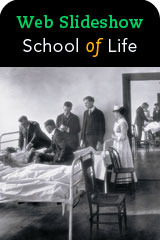Medical education has made Alabama a powerhouse of discovery and development, leading to an endless stream of breakthroughs beyond the five highlighted in UAB Medicine. Here are a few key examples:
• In 2006, an international team of scientists led by UAB researchers discovered a crucial missing link in the search for the origin of HIV-1, the virus responsible for human AIDS. That missing link is the natural reservoir of the virus, found in wild chimpanzees in southern Cameroon. the study, UAB Professor of Medicine Beatrice H. Hahn, M.D., and her team conducted the first-ever molecular epidemiological survey of SIVcpz infection in wild-living chimpanzees in west-central Africa.
• The UAB Center for AIDS Research was the first to perform clinical trails of the protease inhibitor Indinavir (Crixivan), one of the first protease inhibitors used in the “triple drug cocktail” to fight HIV.
• UAB researchers also showed, for the first time, that the AIDS virus replicates early and aggressively soon after a person is infected with HIV. That discovery changed the way clinicians treat HIV infection.
• UAB investigators were the first to demonstrate the value of viral load testing in clinical practice. This test allows physicians to follow the response to antiretroviral treatment, much as they follow the blood-sugar response to insulin when treating diabetics.
• In 1960, Basil Hirschowitz M.D., Ph.D., was the first to explore the stomach with the fiber-optic endoscope, which he helped invent. The device was first utilized regularly at University Hospital and helped revolutionize diagnostic care; its prototype is now in the Smithsonian Institution.
• In 1977, Richard Whitley, M.D., administered a systemic antiviral for the treatment of the deadly HSV (herpes simplex virus) encephalitis, leading to the world’s first effective treatment for a viral disease.
• UAB researchers were the first to discover the protein that led to the development of the well-known drug Viagra, causing what some have called the second sexual revolution.
• Hematology and oncology professor Eric Sorscher, M.D., was the first researcher in the United States to implant a corrected gene into the lungs of patients with cystic fibrosis using a lipid molecule delivery system.
• Max D. Cooper, M.D., was the first to characterize B cells as part of the human immune system. He also was first to successfully treat SCID (severe combined immunodeficiency disease) with the transplant of fetal liver cells.
• In 1984, UAB Hospital became the first hospital in the United States to use color Doppler echocardiography for visualizing internal cardiac structures.
• In 1987, the world’s first genetically engineered mouse-human monoclonal antibody was used at UAB Hospital in the treatment of cancer.
• UAB researchers were the first to discover that people with lupus have significantly higher levels of a particular protein called B-lymphocyte stimulator (BLyS) than people who do not have the disease. Researchers also found that this protein stimulates the immune system to produce damage-causing antibodies in people with lupus.
• UAB researchers were the first to develop an antibody that causes the death of harmful cancer cells and those active in autoimmune diseases such as lupus and rheumatoid arthritis.
• UAB is among only four schools in the nation with an NIH Neurosciences Interdisciplinary Center Grant that links investigators from institutions across the state and region to speed up discovery and development of new drugs and therapies for neurological diseases.
• Tim Townes, Ph.D., professor of biochemistry and molecular genetics, and his team were the first to cure humanized sickle cell anemia in mice. The study also was the first proof of principle of a therapy using induced pluripotent stem cells (stem cells derived from skin cells) to cure disease in an animal model.
